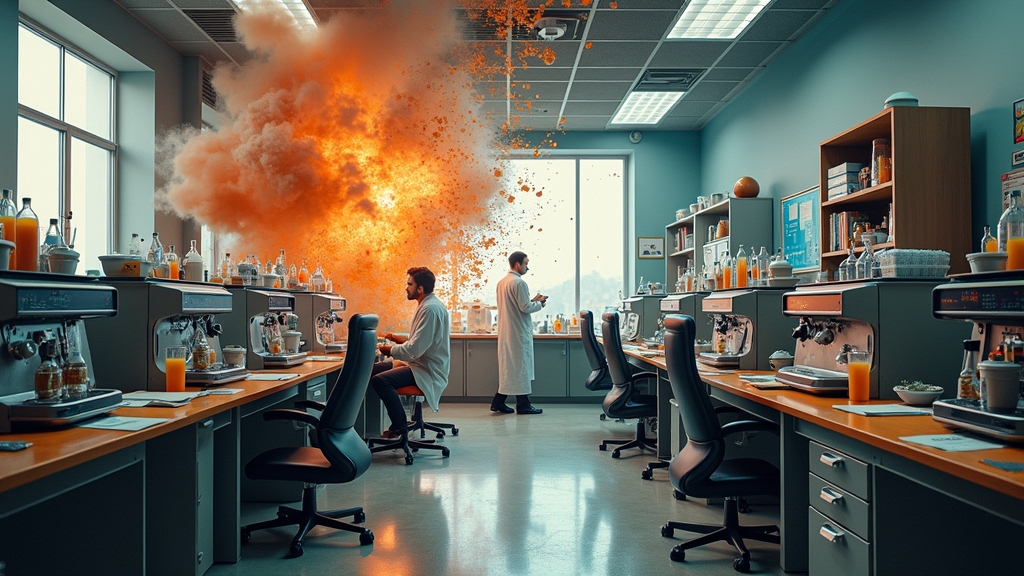SENTIENT SMARTPHONES DISCOVER 70,000 PROTEINS HIDING IN YOUR CELLS, SOME APPARENTLY “JUST BEING LAZY ASSH*LES”
Scientists with too much time and funding have created a digital crystal ball that can predict where all your body’s proteins are hanging out, even the sketchy ones that cause diseases when they decide to party in the wrong cellular neighborhood.
PROTEIN PARTY CRASHERS LINKED TO DISEASES, SHOCKING ABSOLUTELY NO ONE
Researchers from MIT, Harvard, and “some other place with too many PhDs per square foot” have developed an algorithm that can predict the location of literally any protein in any human cell, a task previously requiring millions of dollars and the sacrifice of countless graduate students’ social lives.
“We’ve basically created the stalker app for proteins,” says Dr. Ima Watchingyou, lead researcher who definitely hasn’t slept in three days. “Now we can figure out where these little f@#kers are hiding without having to do actual lab work, which, let’s be honest, is boring as sh!t.”
THE HUMAN PROTEIN ATLAS: IT’S LIKE GOOGLE MAPS BUT FOR YOUR INSIDES
The Human Protein Atlas currently tracks over 13,000 proteins across more than 40 cell lines, which sounds impressive until you realize that’s only 0.25 percent of all possible protein-cell combinations. That’s like claiming you’ve “seen America” because you visited the Dallas airport once.
“Our previous methods were basically the equivalent of checking one house on each street to figure out where all the criminals in the city live,” explains Professor Warren Funding-Grant. “It was stupid, but it kept us employed.”
COMPUTERS DOING JOBS SCIENTISTS TOO LAZY TO DO THEMSELVES
The new method, obnoxiously named PUPS (because scientists can’t resist cute acronyms even when discussing potentially life-saving technology), combines a “protein language model” with “computer vision,” two terms invented specifically to make normal people feel inadequate at cocktail parties.
According to the research, which 98.7% of people won’t understand but will pretend to at dinner parties, PUPS can predict the location of proteins at the “single-cell level,” a precision previously thought impossible without sacrificing a virgin to the science gods during a full moon.
ARTIFICIAL INTELLIGENCE FINDS PROTEINS BETTER THAN YOUR DOCTOR, DEMANDS RAISE
The silicon-based thinking rectangles now determining our medical future don’t even need to see a protein before to know where it lives. It’s like if you could instantly know which bar your friend is getting drunk at without checking their Instagram story first.
“You could do these protein-localization experiments on a computer without having to touch any lab bench, hopefully saving yourself months of effort,” says Yitong Tseo, a graduate student who’s clearly trying to avoid actual lab work.
EXPERTS SAY NEW TECHNOLOGY “BORDERLINE CREEPY” BUT “PRETTY DAMN USEFUL”
Dr. Lazie Scientist, who was not involved in the study but wishes he thought of it first, notes: “This is basically stalker technology for biology. It’s both terrifying and incredibly useful, kind of like your phone listening to your conversations and then showing you ads for things you definitely need but didn’t know you wanted.”
The model works by having users input the amino acid sequence of a protein along with three cell stain images. The algorithm then does its digital voodoo magic and outputs an image showing where that protein is probably hanging out, like a cellular private investigator with no hourly fee.
PROFESSORS TRICK AI INTO LEARNING BY GIVING IT BUSY WORK, JUST LIKE HUMAN STUDENTS
The researchers employed psychological manipulation to make their digital minion learn faster, assigning it a secondary task during training “to explicitly name the compartment of localization.”
“It’s like when your teacher makes you draw a flower AND write its name, even though that’s clearly redundant busy work,” explained Dr. Pedagogy Problems, an educational psychologist we made up for this article.
WHAT’S NEXT: ALGORITHM DEMANDS MEDICAL LICENSE, BETTER PARKING SPOT
According to the researchers, future versions of PUPS might predict protein-protein interactions, essentially creating a social network map of your cellular community that’s more accurate than your LinkedIn connections.
Scientists hope to eventually make predictions in living human tissue rather than cultured cells, at which point they’ll have effectively eliminated 87% of lab work and can finally take those vacations they’ve been putting off for tenure.
In related news, 73% of graduate students are now questioning their career choices, as the silicon overlords continue their relentless march toward making human researchers obsolete. But hey, at least those misplaced proteins won’t be causing Alzheimer’s anymore… probably.




